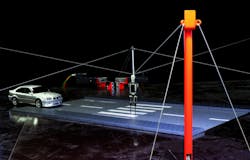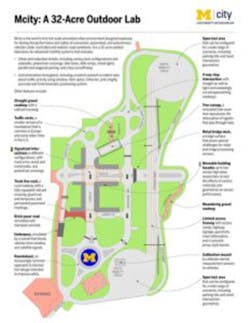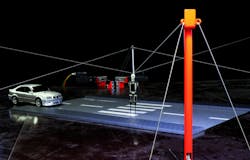Controlled environments help evaluate connected vehicles
If you want to test an autonomous or nearly autonomous vehicle, you can operate on open public roads, as Google has done, logging more than a million miles in cities including Mountain View and Austin with its modified Lexus SUVs and cars of its own design. Such an approach, however, requires the cooperation of relevant authorities, entails risks, and makes it difficult to conduct repeatable experiments.
Consequently, you might find it more effective to establish a controlled test environment. That’s the approach taken by teams in the United States and Europe in the interest of proving out safe, efficient intelligent vehicles. And whether you’re operating in an open or controlled environment, you might encounter problems that test and measurement companies might help you solve.
Test environment, not track
First, the University of Michigan opened what it calls Mcity, a 32-acre simulated urban and suburban environment that includes roads, signs, signals, building facades, sidewalks, and various obstacles (Figure 1). Peter Sweatman, director of the University of Michigan’s Mobility Transformation Center (MTC), described Mcity at the time of the opening on July 20 as a “unique environment” that’s “not a test track, it’s a test environment for automated connected vehicles of the future.” He added, “So this is where we are actually going to be figuring out how we get the incredible potential of connected and automated vehicles to be realized much faster. We learn very fast in a dense, complex environment like Mcity.”
Courtesy of University of Michigan
Figure 1b. Map of Mcity
Courtesy of University of Michigan
The University of Michigan reported that about $10 million have been invested in Mcity, launched in 2013 and with construction beginning in 2014.
The initiative seems Michigan-centric, to the point where Tom Ashbrook, host of Onpoint Radio, titled his program on Mcity “Detroit vs. Silicon Valley.”1 Indeed, many Michigan officials attended the opening, and Michigan Gov. Rick Snyder stated, “We’ve been a world leader in innovation, especially in terms of mobility. We put the world on wheels. We transformed how the world moved. Michigan is uniquely positioned to continue to be a leader in mobility, and the University of Michigan’s new Mcity will play a critical role in that future.”
Nevertheless, as Michael Ramsey, automotive industry reporter for the Wall Street Journal, pointed out on Ashbrook’s program, the contest might be better viewed as traditional automakers vs. Silicon Valley. While the 15 Mcity participants committed to investing $1 million in the initiative over three years include GM and Ford Motor, they also include Honda Motor, Nissan Motor, and Toyota Motor. Other participants include parts manufacturers, signal manufacturers, and telecom companies.
And even saying “traditional automakers vs. Silicon Valley” might be overstating the case. Although it’s not headquartered in Silicon Valley, Qualcomm Technologies is on the list, adding a West Coast high-tech flavor.
MTC reports that a key goal is to put a shared network of connected, automated vehicles, including driverless vehicles, on Ann Arbor roads by 2021. And a project launched three years ago2 will ultimately result in 9,000 connected vehicles operating across the greater Ann Arbor area.
Focus on pedestrian safety
In another initiative, crash-test facility manufacturer MESSRING announced in June that it has made progress in the Target Development for Testing of Integrated Safety Systems (TargETS), a joint research project with TH Ingolstadt University to investigate active safety testing for pedestrian-protection assistance systems.
The goal here is not specifically to test fully autonomous vehicles but rather to test out semi-autonomous functions that can assist drivers. MESSRING cited German Road Safety Council figures showing that approximately 34,000 accidents involving cars and pedestrians each year in Germany are mainly the fault of the drivers, who in most cases are driving a passenger car. The goal is to develop new safety systems that activate before a potential accident to prevent or reduce the severity of crashes.
MESSRING’s project proposal with TH Ingolstadt University was approved by the Federal Ministry for Economic Affairs and Energy, and the project officially launched in October 2013. MESSRING reported that the project is applicable for all assistance systems in the automotive industry, including radar, infrared, stereo camera systems, and laser scanners.
The project comprises two components: a pedestrian dummy and a motion system, which are synchronized with each other using software. The coordination motion system and pedestrian dummy have resulted in a test system that can take a pioneering role in the further development of active safety testing and autonomous driving. “Our motto is ‘action instead of reaction.’ With TargETS, we demonstrate that MESSRING also is an innovative partner in research. We’d like to get more involved in this area in the future too,” explained Wolfgang Rohleder, manager of sales and application at MESSRING.3
The university is doing research involving the true-to-life pedestrian dummy—currently with 21 muscle groups—to ensure its movement patterns enable it to be correctly recognized as a pedestrian by vehicle assistance systems. It can simulate pedestrian movement from a slow walk to spontaneous sprinting.
At the same time, MESSRING is developing the motion system, the 6D Target Mover (capable of three translational and three rotatory movements) that realistically moves the pedestrian dummy within a 9 x 9 meter area (Figure 2). Rods attached to the pedestrian dummy are made from nonconductive materials to avoid confusing radar-based assistance systems.
Courtesy of MESSRING
Earlier test systems, the company reported, often have failed to realistically simulate human movement patterns. For example, linear cross-beam systems suspend a dummy from a bridge-and-track construction that can only facilitate movement in a straight line, but two-thirds of all pedestrians do not cross the street in a straight line.
The role of instrumentation
You’ll need the help of electronic test equipment to fully test your connected vehicle. To that end, in July Spirent Communications launched its Automotive Record and Playback test system to help drive innovation and improvements in the rapidly evolving vehicle navigation and connected-car ecosystem.
The test system enables automotive system developers to record real-world signals and then replay them repeatedly in development labs to shorten the time taken to validate new hardware or software. This lab-based approach complements the conventional field testing using fleets of vehicles. It also will help to minimize the development and validation time for new features for vehicle-to-vehicle (V2V) communication technology. V2V communications could mitigate many traffic collisions and reduce traffic congestion by sending and receiving basic safety information such as location, speed, and direction of travel between vehicles approaching each other.
“By providing vehicle manufacturers with a wide range of test capabilities from the wireless, positioning, and computer networking industries that complement drive testing, we can help the auto industry adopt connected-car technology with more confidence,” said Pete Nicholson, general manager of Spirent’s Automotive Business Unit, in a press release. “Our system allows automotive OEMs to develop and validate new products more quickly, by making tests repeatable using real-world signals in a lab environment.”
The Spirent system provides RF recordings for all the major Global Navigation Satellite Systems (GNSS)—GPS, GLONASS, Galileo, BeiDou, and QZSS—and vehicle CAN bus data. The system also can record up to four video streams, audio, and other high-speed sensor data to provide a complete record of the route. The recorded data is timestamped and then can be replayed repeatedly to help engineering teams verify that new designs work all over the world without leaving the lab.
And finally, Teledyne LeCroy has introduced two new trigger and decode options for the WaveSurfer 3000 oscilloscope: CAN FD and FlexRay. The addition of CAN FD and FlexRay trigger and decode capabilities to the WaveSurfer 3000 provides the tools needed to analyze and debug automotive systems using the CAN FD and/or FlexRay serial data communication standards. New protocol analysis capabilities with CAN FD and FlexRay trigger and decode enable engineers and technicians working with these standards to gain insight into their systems, correlating physical layer signals and protocol layer data on a single display.
Compared with CAN, the next-generation CAN FD enables higher bit rates and longer data payloads. CAN FD goes beyond the 1-Mb/s limit of classic CAN and will transmit data at up to 10 Mb/s. CAN FD data payloads may now consist of 64 bytes per frame as opposed to the eight bytes per frame limit of classic CAN.
FlexRay supports data rates up to 10 Mb/s, static and dynamic transmission, and synchronous and asynchronous message protocols, and it has a time-triggered deterministic architecture. In addition, FlexRay can have two independent channels for data communications, which allow for redundancy and fault tolerance.
References
- Ashbrook, T., “Detroit vs. Silicon Valley: The Future of the Driverless Car,” Onpoint Radio Podcast, July 21, 2015.
- Nelson, R., “Cars Talk Safety in Ann Arbor,” EE-Evaluation Engineering Online, Aug. 29, 2012.
- “MESSRING test system focuses on pedestrian protection,” EE-Evaluation Engineering Online, June 11, 2015.
For more information



